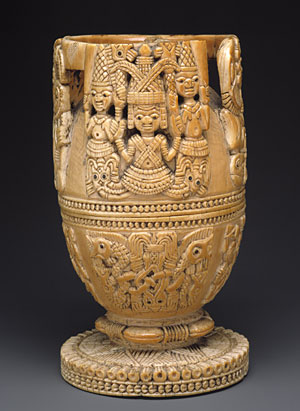
 |
|
|||||||||||||||||||||||||||||||||||||||||||||||||
 |
Colonialism
During the early 19th century the British had decided to abandon the trading of slaves. The economic benefits had long waned and the moral issues involved were too stark for the British establishment to continue the pursuit. Instead their eyes vied for more substantial quarry that of African territory itself and the abundance of wealth it contained. |
In 1851 the first steps towards colonialism were taken. Military force was used by the British Consul against Kosoko of Lagos who was branded a slave trader and therefore an obstacle of legitimate trade by the Christian missionaries and the British traders. The bombardment of Lagos was a significant and unprovoked step in the process by which the British took control of Yorubaland. This foothold was further consolidated in 1861 when Lagos was made a British colony. The reason this time, for their actions was that its leader Dosumu was too weak to rule. With Lagos so firmly held, the British were well placed for any offensive, if need be, against Yoruba rulers. But at the time the civil wars that were raging in the interior of Yorubaland made Christian expansion difficult and in some cases impossible. Trade also couldn't flow as freely as the traders based in Lagos and Badagry wanted. The disruption of trade also meant that there was a decrease in custom dues which the British administration relied on for its revenue. All this necessitated external intervention in order to end the war. As the involvement of all the Yoruba in these wars made internal arbitration impossible and as they were getting war-weary, this external intervention was most welcome by the Yoruba themselves. Unfortunately the Yoruba were completely oblivious to the hidden intentions of the peace makers. After preliminary peace-making efforts were initiated by the missionaries, the British administration in Lagos finally helped bring the wars to an end. In the process of restoring peace, the agents of British authority lost no opportunity in increasing and improving the chances of an eventual British take-over of Yorubaland. In a series of treaties drawn in 1886, 1888 and 1893, parts of Yorubaland were turned into British spheres of influence. These treaties were the prelude for the eventual take-over. However for the final steps of colonial rule to take place military force was required. It first began in Ijebu in 1892. Until that time the Ijebu did not usually open their territory to strangers. The Christians and Muslims had for sometime found this region of Yorubaland very difficult to penetrate. Similarly a closed door policy was pursued towards the traders from Lagos . The British administration couldn't let the situation persist for among other things Ijebu territory formed a vital point in the trade route linking Lagos with the interior. Through the use of a provocative visit by a British official, they found an adequate pretext for dealing with Ijebu intransigence. The Ijebu were accused of not showing respect to the British Crown. This alleged insult was revenged by a military expedition in 1892 to Ijebu Ode which quickly capitulated in the face of superior British weaponry.
The Conquest of Yorubaland
The invasion of the Ijebu became an object lesson to other parts of Yorubaland. Governor G. Carter who had achieved the conquest of Ijebuland faced little or no opposition when he made his famous journey through Yorubaland in1893 to put a final end to the Yoruba civil wars. He easily got the Egba to sign a treaty that the British simply ignored. Similarly, Carter found no serious opposition in sending away the Yoruba warriors from Ikirun and Ofa camps. More important was the fact that Carter succeeded with relative ease in making the rulers of Ibadon, one time terror of Yorubaland, accept the stationing of a British resident among them. And it was one such resident that completed the final subjugation of Yorubaland. This was Captain R. L. Bower, who in early 1894 firstly began intimidating the Ibadan chiefs. He then humiliated the strong man of Ilesha, Ogedengbe and finally brought the Alaafin of Oyo to submission. As in the case of the Ijebu, the British used force against the Alaafin and his chiefs. Under the excuse that he was championing the cause of the oppressed, Captain Bower bombarded Oyo in November 1895. Alaafin Adeyemi I, had to flee for his life, when his palace was set ablaze as a result of constant shelling. He was only allowed to return to his throne after giving an assurance of his readiness to accept British authority. Earlier in 1884 at the Berlin Conference, the entire region was accepted as belonging to the British in the Scramble for Africa. By 1900 the British had accepted responsibility (though not yet all the territory was under British control) for an area that not only included nearly all of Yorubaland but one that stretched to Sokoto and Bornu in the north. An area so vast that the British found it impossible to cope single-handedly with the problem of administration. They resorted to the use of the ‘indirect rule' method of ruling by which indigenous functionaries were allowed to administer their territory under the supervision of British officials.
|